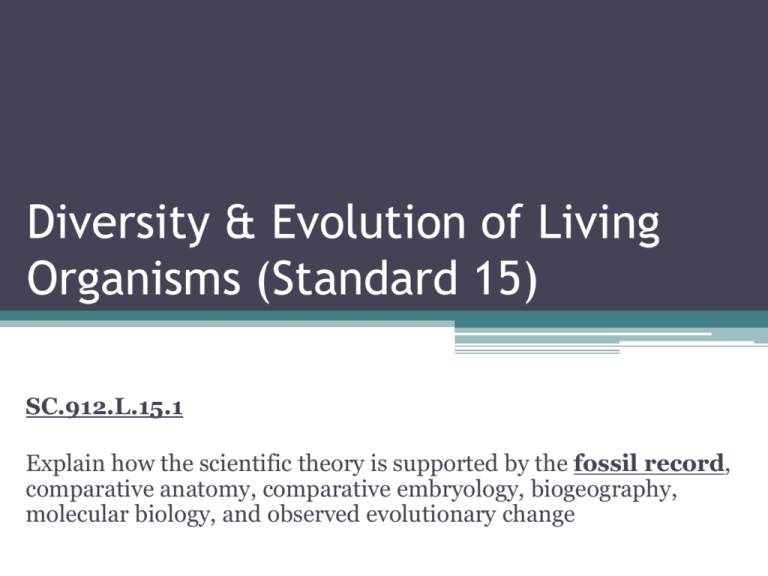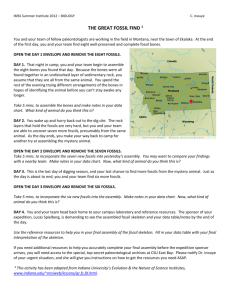File - Science Math Master
advertisement

Diversity & Evolution of Living Organisms (Standard 15) SC.912.L.15.1 Explain how the scientific theory is supported by the fossil record, comparative anatomy, comparative embryology, biogeography, molecular biology, and observed evolutionary change EVOLUTION SURVEY http://www.indiana.edu/~ensiweb/lessons/ev.surv.pdf http://www.indiana.edu/~ensiweb/lessons/ev.surv.html VERY IMPORTANT: Please indicate whether each following statement is true or false, in terms of how you think biologists use and understand the term "evolution" today. YOU DO NOT have to AGREE with the statement for it to be "true". Your answers will be confidential, and will not affect your grade. In every case below, "evolution" means "biological evolution". Using your Plicker card “A” for TRUE “B” for FALSE Plickers www.plickers.com Evolution Survey 1. According to evolution, people came from monkeys along time ago. 2. Evolution is something that happened only in the past; it is not happening now. 3. Evolution was developed as an idea to destroy or undermine religion. 4. Evolution has been tested and challenged many times, but has always been supported by the results 5. Big dinosaurs were common during the time of early humans. Fossil Records – Great Fossil Find In this activity, you and your partner will play the roles of paleontologists working in the field in Montana, near the town of Ekalaka. One clear crisp afternoon in October, you find four well preserved and complete fossils. http://www.indiana.edu/~ensiweb/lessons/gr.fs.fd.ht Day 1 Open envelope 1 and remove 4 fossils. Day 1: That night in camp, after dinner, around a Coleman lantern, you and your colleagues begin to assemble the 4 bones you found earlier. Since the bones were all found together in an undisturbed layer, you assume that they are all from the same animal. You spend the rest of the evening trying different arrangements of the bones in hopes of identifying the animal before you get tired. Take 5 minutes to assemble the bones and make notes in your data chart. Day 2 Day 2: You wake up to a beautiful Montana morning and you hurry back out to the dig site. The rock layers that hold your fossils are very hard and only give up three more specimens. As the day ends you make your way back to camp for another try at assembling the mystery animal. 1. Open envelope and remove 3 fossils. 2. Take 5 minutes to assemble all 7 bones and make notes in your data chart. 3. What kind of animal do you think this is now? Day 3 Day 3: The next morning is cold. You can tell that winter is just around the corner and you know that this will be the last day of the digging season, and your last chance to find more fossils of the mystery animal. Just as the day is about to end, one of the members of your team finds 3 final bones. 1. Open envelope and remove 3 fossils. 2. Take 5 minutes to assemble all 10 bones and make notes in your data chart. 3. What kind of animal do you think this is now? Day 4 Day 4: Back in the lab, you meet up with some Paleontologist friends. They tell you they have spent the summer working in a different location but with the same geological period. You show them the skeleton you found, and they tell you they have a similar one, but it looks like they have some different bones that you don’t have. 1. For 5 minutes, compare your fossils with those of a group near you, looking for clues that will help you assemble your fossils. Apply these clues to your interpretation of your skeleton. 2. What type of animal do you think you have now? Day 5 Day 5: In the library at school you find a Skeletal Resource Manual with drawings of the skeletons of some existing animals. You notice some interesting similarities between some of the drawings and your unknown fossil. 1. Use the drawings to assist you in your final assembly of the fossil skeleton. Fill in the data table with your final interpretation of the skeleton. 2. When you are finished, pick up the poster instructions at the front and start working on your poster with your partner. Skeletal Resource Manual http://www.indiana.edu/~ensiweb/lessons/gff.man.pdf Poster Instructions • http://www.indiana.edu/~ensiweb/lessons/gff.post.pdf Include in your Poster: • The type of animal you think your fossils were, including a name • A drawing of what the animal might look like • Where the animal might have lived (in water, on land, on land and in the air) and why you think so • What you originally thought the animal was on Day 1 • The biggest piece of evidence that caused you to change your interpretation from Day 1 to Day 5 • What new pieces of evidence (such as another fossil from the animal) might support your hypothesis about these fossils? • What new piece of evidence might prove that your interpretation of these fossils is inaccurate? Activity - Twizzler Half-Life Lab Purpose: develop a working definition of a half-life In this activity, you will simulate the radioactive decay of an isotope using Twizzlers http://www.rsec.psu.edu/pages/education/lessons/Twizzler%20Half-Life.pdf Comparative Anatomy http://www.sporcle.com/games/cbdollyy/animalskullsmatching Comparative Embryology http://www.pbs.org/wgbh/nova/evolution/guess-embryo.html Post Assessment- Hook Video • Coat Color in Pocket Mouse ▫ http://www.youtube.com/watch?v=-amfHWk93AA






